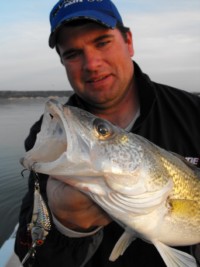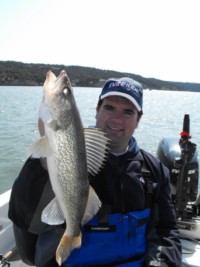Small Baits Fish Big
Category: article
Apr 30th, 2010 by OutdoorsFIRST
Modified Apr 30th, 2010 at 12:00 AM
On many walleye fisheries across the Midwest, young of the year fish hatches play a huge role in where to fish and what to fish with. Really strong reproductive efforts of just about any fish species are taken advantage of. Heavy predation has been documented on just about every species of fish if the conditions dictate. While the significance of young of the year yellow perch, crappies, white bass, gizzard shad and even bullheads are well known. There are situations where walleyes will feed heavily on young of the year paddle fish or even other walleyes. When conditions are right for a tremendous amount of eggs to hatch and emerge into fry, walleyes usually take advantage regardless.
 |
|
|
|
The sure way to know exactly what walleyes are feeding on means cutting open a few fish or at least see what fish are coughing up in the live well. Knowing and understanding what baitfish is on the menu gives an angler a much deeper understanding of the patterns. “Matching the hatch” is a term that is often thrown around but in my opinion… instead of trying to match the color of your bait to what fish are eating, a better mindset might be matching where and how you are fishing to what the fish are eating.
Anglers spend a tremendous amount of time trying to learn everything they can about walleyes because that is the fish they want to catch but many walleye anglers would be better served learning all they can about the baitfish that walleyes are feeding on. Remember that for the most part, these patterns really change drastically from year to year. For various reasons, conditions might be perfect for perch to pull off an unbelievable year class. As you can guess, walleyes will adjust their schedule accordingly. On the same lake the next year, because of different conditions… the perch reproduction might be poor but the shiner reproduction or the shad reproduction might be off the charts.
Now how does understanding what the fish are keying on each season help you catch more fish? Simple, if you have a deep understanding of why fish are in an area and can imagine what the fish are eating, it becomes easier to make better decisions when out on the water. Remember however that on most fisheries, there is more than one species of forage and that there are usually different patterns happening at the same time. What makes this puzzle even more complex is those baitfishes often occupy different niches and types of habitats on different lakes. On some lakes, perch might tend to occupy shallow chara flats and that will concentrate walleye location if there is a good number of young of the year perch present. On other lakes, perch might be pushed up tight against shorelines along submerged timber. Smelt or shad might be on an entirely different program.
After these extraordinary fish hatches take place, we often find walleyes literally packed with young fish. Crappies for example might resemble quarters packed into the stomach of a fish. Even fathead minnows that are only an inch long will be stuffed into the stomachs of fish. The stomachs of walleyes often look bloated, firm and packed full of little fish… usually small fish.
With that being said, we often find that we are extremely successful early in the summer using small lures or crankbaits for catching walleyes. Perhaps the reason that small lures that are often three inches in length or less are so effective is because walleyes key in on the small abundant fish that are so readily available. By far, one of the hottest crankbaits for us on Devils Lake in North Dakota, the Missouri River in North and South Dakota, Mille Lacs Lake in Minnesota and the Roy Lake area of South Dakota the past few years has been a small bait, either a number four or number five Salmo Hornet. Anglers are often trolling these lures with braided line down to about twelve feet but some anglers also use snap weights or lead core line to fish these effective lures down to thirty feet or more. While guiding, I don’t know how many times people commented at the lures we were using… how small the lures looked, wrongly assuming that the lures were too small to catch walleyes or wouldn’t catch big walleyes but that opinion usually changed by the end of the day. Walleyes (big walleyes included) often show a preference for small baits and early summer is one situation where really small baits can pay off big.
 |
|
|
|
Traditional thinking also implies that walleyes prefer long slender baitfish and as a result, many traditional walleye lures are long, slender and about four to five inches in length. What is preferred and what is readily available however are two different things. A three week old white bass, crappie or perch has an entirely different profile and displacement. This is why I believe small lures that emit a hard vibration are so effective and why there is a current trend towards using small lures with wider profiles. Note however that small lures were traditionally much more difficult to tune and difficult to track properly through the water and as a result, some anglers might have a bad taste in their mouths about using small crankbaits. To my knowledge, Salmo and Rapala are two lure companies that hand tune lures so if you stick to those brands… you shouldn’t have an issue. When we look at the big picture as far as what fish are eating right now, it becomes obvious as to why the small, compact lures like the Hornets have been so effective and popular over the past few years.